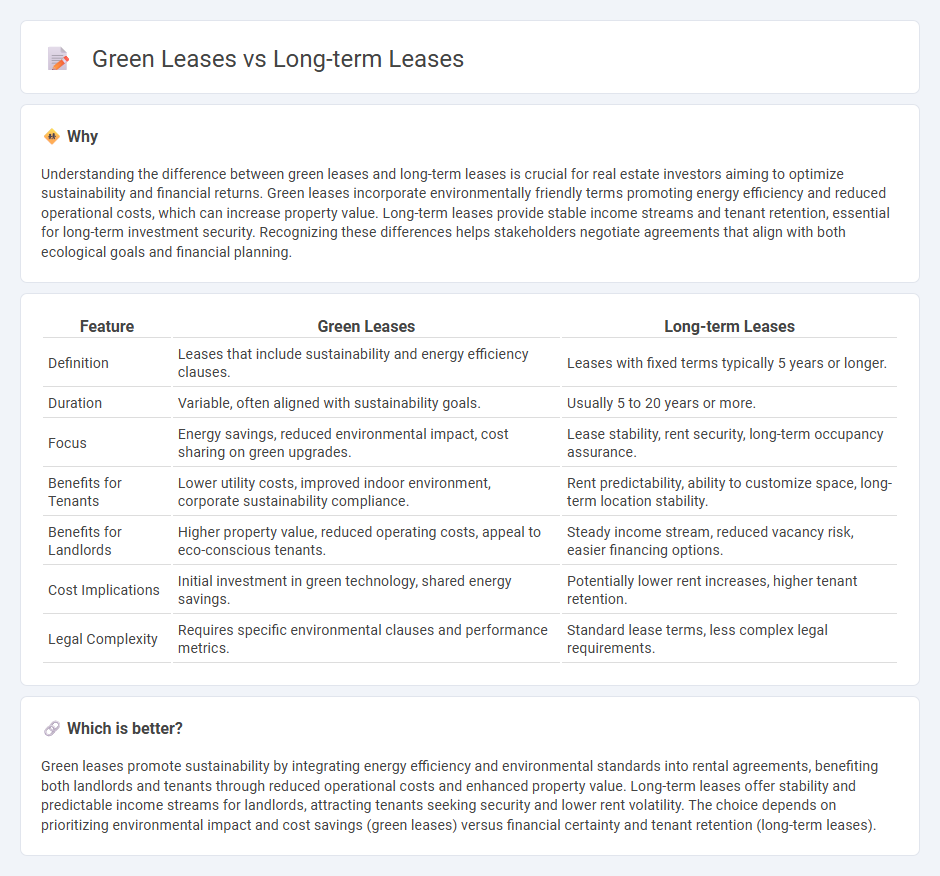
Green leases promote energy efficiency and sustainability by integrating environmental goals into rental agreements, reducing operational costs and carbon footprints for both landlords and tenants. Long-term leases offer stability and predictable income by securing rental agreements spanning multiple years, benefiting tenants with consistent occupancy and landlords with reliable revenue. Explore the advantages and key differences between green leases and long-term leases to optimize your real estate investment strategy.
Why it is important
Understanding the difference between green leases and long-term leases is crucial for real estate investors aiming to optimize sustainability and financial returns. Green leases incorporate environmentally friendly terms promoting energy efficiency and reduced operational costs, which can increase property value. Long-term leases provide stable income streams and tenant retention, essential for long-term investment security. Recognizing these differences helps stakeholders negotiate agreements that align with both ecological goals and financial planning.
Comparison Table
| Feature | Green Leases | Long-term Leases |
|---|---|---|
| Definition | Leases that include sustainability and energy efficiency clauses. | Leases with fixed terms typically 5 years or longer. |
| Duration | Variable, often aligned with sustainability goals. | Usually 5 to 20 years or more. |
| Focus | Energy savings, reduced environmental impact, cost sharing on green upgrades. | Lease stability, rent security, long-term occupancy assurance. |
| Benefits for Tenants | Lower utility costs, improved indoor environment, corporate sustainability compliance. | Rent predictability, ability to customize space, long-term location stability. |
| Benefits for Landlords | Higher property value, reduced operating costs, appeal to eco-conscious tenants. | Steady income stream, reduced vacancy risk, easier financing options. |
| Cost Implications | Initial investment in green technology, shared energy savings. | Potentially lower rent increases, higher tenant retention. |
| Legal Complexity | Requires specific environmental clauses and performance metrics. | Standard lease terms, less complex legal requirements. |
Which is better?
Green leases promote sustainability by integrating energy efficiency and environmental standards into rental agreements, benefiting both landlords and tenants through reduced operational costs and enhanced property value. Long-term leases offer stability and predictable income streams for landlords, attracting tenants seeking security and lower rent volatility. The choice depends on prioritizing environmental impact and cost savings (green leases) versus financial certainty and tenant retention (long-term leases).
Connection
Green leases encourage sustainable building practices by integrating energy efficiency and environmental goals into lease agreements, which often span long-term durations to maximize impact. Long-term leases provide stability for both landlords and tenants, facilitating investments in green technologies and infrastructure that require extended payback periods. By combining green lease provisions with long-term commitments, stakeholders align financial incentives with environmental sustainability in real estate portfolios.
Key Terms
Lease Duration
Long-term leases typically span several years, often ranging from five to twenty years, providing tenants with stability and landlords with predictable income streams. Green leases incorporate environmentally sustainable clauses, aligning lease duration with energy efficiency targets and enabling periodic updates to meet evolving green standards. Explore more to understand how lease duration impacts financial benefits and sustainability commitments.
Sustainability Clauses
Long-term leases traditionally offer security and predictability for tenants and landlords but often lack specific provisions addressing environmental performance. Green leases incorporate sustainability clauses that promote energy efficiency, waste reduction, and responsible resource use, aligning landlord and tenant goals for lower carbon footprints and operational cost savings. Explore how integrating green lease terms can advance your commitment to sustainable property management and environmental responsibility.
Operating Expenses
Long-term leases often include fixed operating expenses that may not reflect actual utility consumption or sustainability efforts, whereas green leases actively incorporate clauses that promote energy efficiency, waste reduction, and lower environmental impact in operating costs. Green leases align financial incentives between landlords and tenants, encouraging shared responsibility in reducing utility expenses and improving building performance. Discover how green leases transform operating expense management and create sustainable leasing agreements.
Source and External Links
What Is a Long-Term Lease? How to Win with Long-Term Property - This article discusses the benefits and types of long-term leases, including one-year, two-year, multi-year, and corporate leases, highlighting their advantages for both landlords and tenants.
Lease Guide: Pros and Cons of Long-Term Rental Agreements - This guide outlines the pros and cons of long-term leases, which last for a year or more, providing stability and benefits for both tenants and landlords.
Pros & Cons of Long-Term Leases: Guide for New Investors - This article provides a comprehensive overview of the advantages and disadvantages of long-term leases, including stability, pricing stability, and potential drawbacks like inflexibility.
 dowidth.com
dowidth.com